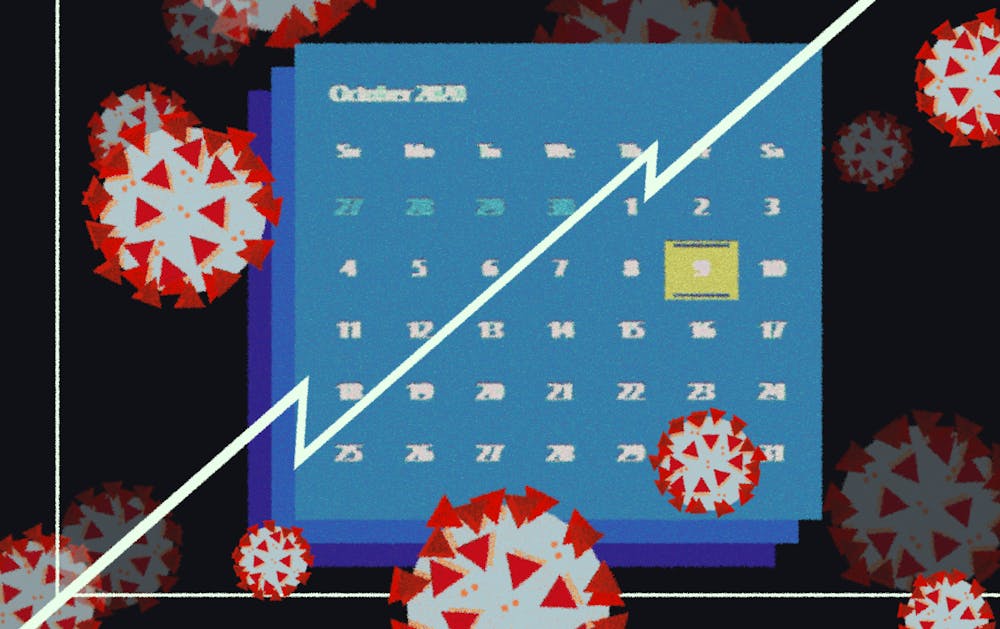After Arizona went through a tumultuous summer with high average daily infection rates of the coronavirus, new daily cases dropped at the start of fall.
But the several weeks of low numbers of new cases within the state and ASU community are no longer, said two of the University's leaders in its response efforts, Joshua LaBaer and Neal Woodbury, who are concerned about where the state's coronavirus data is headed.
Woodbury, interim executive vice president of ASU's Knowledge Enterprise, said the curve of infections flattened but is rapidly climbing again in the state.
Woodbury said in October the spread of the virus had not been as prevalent within the University, but it would not escape the coronavirus' reach, saying "of course" the virus will spread within ASU's community.
Coronavirus trends at the University
According to a Monday update from the University, there have been 3,248 students and employees who have tested positive for COVID-19 since Aug. 1. There are 401 active infections, with 300 of them being students and 101 of them being employees.
Before the semester started, students were required to complete a Community of Care training teaching them about University protocol, symptoms of COVID-19 and how to stop the spread.
Students were required to test negative for the coronavirus before moving into University Housing. Woodbury said the move-in process and subsequent gathering of students could have caused some of the positive cases the University reported early on when it decided to disclose data.
Rather than cases spreading in classrooms and residence halls, Woodbury and LaBaer said spread is more likely occurring off-campus.
The University reported Monday 234 of the 300 active student cases are off-campus in the metropolitan Phoenix area, 52 are in isolation on the Tempe campus and 14 are on the Downtown Phoenix, West or Polytechnic campuses.
While pinpointing when and where the virus is spreading can be difficult, especially when cases remain relatively low in the ASU community, infections occurred more often after move-in and following Halloween than any other time this semester.
Since less students have interacted on-campus than was expected before the semester began, University spokespeople said, the number of infections has not stayed constant.
When the University began to include the cumulative number of cases, close to 1,500 students had already been infected. Active infections reached a peak in early September when the University reported 983 cases. In early October, active cases tapered off to about 200, with some updates reporting under 100 before Halloween.
But active cases spiked again after Halloween, reaching 449 active cases a little over two weeks after the holiday.
According to Monday's update, between Nov. 23 and 29, 500 on-campus students, 1,544 off-campus students and 788 employees had complied with the University's random testing. Seven on-campus students, 31 off-campus students and five employees tested positive.
In late October, Woodbury said around 50% of students living in residence halls and just 25% of students living off-campus were complying with the University's random testing program. Woodbury said testing at random allows for a better picture of how many students have the virus and whether or not the amount of testing is efficient.
To increase compliance, Woodbury and LaBaer said they're hoping to give students selected for random testing more time to report to a testing location and remind students they should get tested to ensure they do not have the virus, even though they may not want to know.
Coronavirus trends in the state
A week into the semester, daily average cases had decreased from about 1,500 to about 600 and continued to do so for weeks, reaching as low as 200 on weekends, according to data reported by the Arizona Department of Health Services. But now, the state has reported thousands of positive cases for several days consecutively, with few exceptions to the trend.
On Monday, the state reported 822 new cases and five additional deaths, increasing state totals to 326,817 total infections and 6,639 total deaths.
Gov. Doug Ducey reaffirmed Arizona was open roughly two weeks ago, saying a rise in cases would not, and should not, cause dramatic changes in the way the state is operating.
ASU President Michael Crow sent a letter to the Maricopa County Board of Supervisors on Oct. 7 asking the county-wide mask mandate stay in place past possible changes or repeals before the end of the year.
His letter said the mask mandate would benefit the health and safety of students and faculty at the University along with other citizens residing in Maricopa County.
A study published by the Centers for Disease Control and Prevention and authored in part by ADHS Director Dr. Cara Christ showed cases in Arizona spiked 151% after the state's stay-at-home order expired in May. Cases dropped 75% after local municipalities, Maricopa County included, instituted its own mask mandate.
However, LaBaer, executive director of ASU's Biodesign Institute, said in a media briefing last week the data the state is seeing now is very similar to data from June.
"Overall the pandemic in Arizona is not looking encouraging," he said. "Arizona has been on an exponential rise pretty much since the start of October, and we continue in that constant rise since there is no sign whatsoever that the state is slowing down."
Last week, LaBaer said hospitalizations are also concerning because of reduced availability and reduced staffing. He said it could only be a few weeks before hospitals reach capacity and testing can be a remedy to stopping the virus before it gets worse.
"The more testing we do, the more quickly we can spot the virus," LaBaer said. "Testing is a supplement, not a substitute."
Reach the reporter at pjhanse1@asu.edu and follow @piperjhansen on Twitter.
Like The State Press on Facebook and follow @statepress on Twitter.

Piper Hansen is the digital editor-in-chief at The State Press, overseeing all digital content. Joining SP in Spring 2020, she has covered student government, housing and COVID-19. She has previously written about state politics for The Arizona Republic and the Arizona Capitol Times and covers social justice for Cronkite News.




